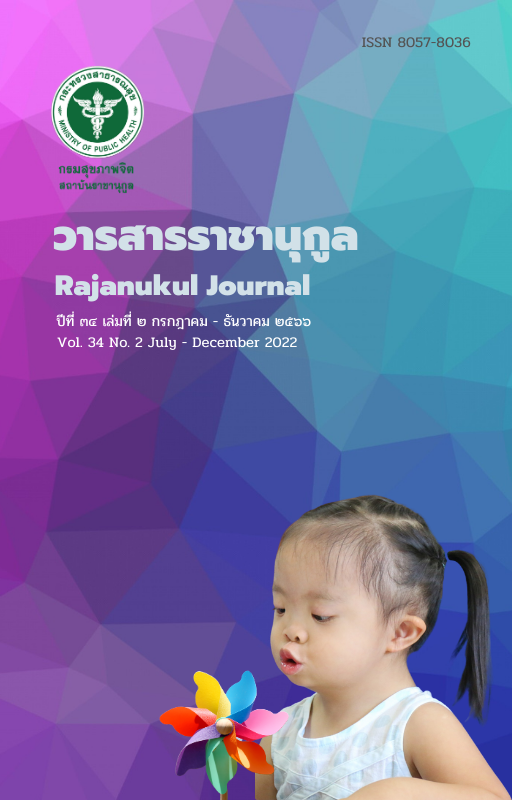เปรียบเทียบการใช้แบบทดสอบ Stanford Binet Intelligence Scale-Fifth Edition และ Wechsler Nonverbal Scale of ability ในเด็กออทิสติกที่มีทักษะการปรับตัวบกพร่อง
คำสำคัญ:
เด็กออทิสติก, ทักษะการปรับตัวบกพร่อง, แบบทดสอบ SB5, แบบทดสอบ WNVบทคัดย่อ
วัตถุประสงค์ เพื่อตรวจสอบความแตกต่างของคะแนนความสามารถที่ได้จากแบบทดสอบ Stanford Binet Intelligence Scale-Fifth Edition (SB5) (เฉพาะด้านที่ไม่เกี่ยวข้องกับภาษา) และ Wechsler Nonverbal Scale of Ability (WNV) ในเด็กออทิสติกกลุ่มที่มีทักษะการปรับตัวบกพร่อง ซึ่งกิจกรรมทดสอบที่ไม่เกี่ยวข้องกับการใช้ภาษาของทั้งสองแบบทดสอบนำไปสู่แนวทางการเลือกใช้ในการปฏิบัติงานจริงได้
วัสดุและวิธีการ เด็กออทิสติกกลุ่มที่มีทักษะการปรับตัวบกพร่องร่วมด้วย (จากการประเมินด้วยแบบประเมิน Vineland Adaptive Behavior Scales แล้วได้ค่า Adaptive Behavior Composite ต่ำกว่า 30) อายุ 4 ปีขึ้นไป เป็นผู้ป่วยจากหอผู้ป่วยออทิสติก 1 2 และ 3 ของสถาบันราชานุกูล จำนวน 37 คน รับการทดสอบทางสติปัญญาด้วยแบบทดสอบ SB5 (เฉพาะด้านที่ไม่เกี่ยวข้องกับภาษา) และแบบทดสอบ WNV โดยค่าความสามารถทางสติปัญญา (ค่า IQ) ที่ได้จากแบบทดสอบทั้งสองนำมาวิเคราะห์ความแตกต่างด้วย Wilcoxon signed-rank test
ผล ค่า IQ จากแบบทดสอบ SB5 ( = 51.05, SD = 12.07) สูงกว่า WNV ( =47.16, SD = 12.23) อย่างมีนัยสำคัญทางสถิติ (Z = -2.483, p= 0.013) นอกจากนี้ เด็กออทิสติกกลุ่มที่มีทักษะการปรับตัวบกพร่องยังสนใจและให้ความร่วมมือในการทำแบบทดสอบ SB5 (เฉพาะด้านที่ไม่เกี่ยวข้องกับภาษา) ที่ใช้การหยิบจับลงมือทำมากกว่าแบบทดสอบ WNV ที่โดยมากใช้การชี้รูปภาพ
สรุป แม้ว่าทั้ง SB5 และ WNV จะเป็นแบบทดสอบมาตรฐานที่สามารถใช้ทดสอบสติปัญญาได้เช่นเดียวกัน แต่สำหรับเด็กออทิสติกกลุ่มที่มีทักษะการปรับตัวบกพร่องที่มักมีข้อจำกัดด้านการสื่อสาร จากการวิจัยครั้งนี้พบว่าแบบทดสอบ SB5 (เฉพาะด้านที่ไม่เกี่ยวข้องกับภาษา) น่าจะเป็นทางเลือกที่ดีกว่า WNV ซึ่งการค้นพบดังกล่าวอาจช่วยสร้างความตระหนักและชี้ให้เห็นว่าแบบทดสอบทางสติปัญญาต่างชนิดกันสามารถดึงความสามารถและเอื้อต่อการตอบสนองของผู้รับการทดสอบได้แตกต่างกัน อันจะนำไปสู่การเลือกเครื่องมือที่เหมาะสมต่อการใช้งานมากขึ้น
เอกสารอ้างอิง
Klaiman C, Fernandez-Carriba S, Hall C, Saulnier C. Assessment of autism across the lifespan: A way forward. Current Developmental Disorders Reports. 2015;2(1):84-92.
Hurlburt RT, Happe F, Frith U. Sampling the form of inner experience in three adults with Asperger syndrome. Psychological medicine. 1994;24(2):385-95.
Tager-Flusberg H. Understanding the language and communicative impairments in autism. International review of research in mental retardation. 23: Elsevier; 2000. p. 185-205.
Boring EG. A history of experimental psychology. 2d ed.. ed. New York: New York : Appleton-Century-Crofts; 1950.
Eagle RS. Accessing and assessing intelligence in individuals with lower functioning autism. Journal of Developmental Disabilities. 2002;9:45-53.
Roid GH. Stanford‐Binet intelligence scales- fifth edition: technical manual. Itasca, IL: Riverside Publishing; 2003.
Roid GH. Stanford‐Binet intelligence scales- fifth edition: examiners' manual. Itasca, IL: Riverside Publishing; 2003.
Naglieri JA, Brunnert K. Wechsler nonverbal scale of ability (WNV). Hoboken, NJ: John Wiley & Sons Inc; US; 2009. 315-38 p.
Roid GH, Miller LJ. Leiter international performance scale-revised (Leiter-R). Wood Dale, IL: Stoelting. 1997;10.
Grondhuis SN, Lecavalier L, Arnold LE, Handen BL, Scahill L, McDougle CJ, et al. Differences in verbal and nonverbal IQ test scores in children with autism spectrum disorder. Research in Autism Spectrum Disorders. 2018;49:47-55.
Sparrow SS, Cicchetti DV. The Vineland adaptive behavior scales: Allyn & Bacon; 1989.
Banire B, Jomhari N, Ahmad R. Visual hybrid development learning system (VHDLS) framework for children with autism. Journal of autism and developmental disorders. 2015;45(10):3069-84.
Colorosa SR, Makela CJ. Integrative literature review: Styles of learning for autism spectrum disorders and human resource development: informing performance management. International Journal of Business and Social Science. 2014;5(13).
Gunn KC, Delafield-Butt JT. Teaching children with autism spectrum disorder with restricted interests: A review of evidence for best practice. Review of Educational Research. 2016;86(2):408-30.
Correa Camargo JAC. Visual worksheets: a tool to enhance fluency and accuracy in a student with Asperger Syndrome (AS): Bogotá: Universidad Externado de Colombia, 2018.; 2018.
Marco EJ, Hinkley LB, Hill SS, Nagarajan SS. Sensory processing in autism: a review of neurophysiologic findings. Pediatric research. 2011;69(8):48-54.
DeThorne LS, Schaefer BA. A guide to child nonverbal IQ measures. 2004.
ดาวน์โหลด
เผยแพร่แล้ว
รูปแบบการอ้างอิง
ฉบับ
ประเภทบทความ
สัญญาอนุญาต
ลิขสิทธิ์ (c) 2023 จันทนี มุ่งเขตกลาง

อนุญาตภายใต้เงื่อนไข Creative Commons Attribution-NonCommercial-NoDerivatives 4.0 International License.
ข้าพเจ้าและผู้เขียนร่วม (ถ้ามี) ขอรับรองว่า ต้นฉบับที่เสนอมานี้ยังไม่เคยได้รับการตีพิมพ์และไม่ได้อยู่ในระหว่างกระบวนการพิจารณาตีพิมพ์ลงในวารสารหรือสิ่งตีพิมพ์อื่นใด ข้าพเจ้าและผู้เขียนร่วม (ถ้ามี) ยอมรับหลักเกณฑ์และเงื่อนไขการพิจารณาต้นฉบับ ทั้งยินยอมให้กองบรรณาธิการมีสิทธิ์พิจารณาและตรวจแก้ต้นฉบับได้ตามที่เห็นสมควร พร้อมนี้ขอมอบลิขสิทธิ์ผลงานที่ได้รับการตีพิมพ์ให้แก่วารสารราชานุกูล กรณีมีการฟ้องร้องเรื่องการละเมิดลิขสิทธิ์เกี่ยวกับภาพ กราฟ ข้อความส่วนใดส่วนหนึ่ง หรือ ข้อคิดเห็นที่ปรากฏในผลงาน ให้เป็นความรับผิดชอบของข้าพเจ้าและผู้เขียนร่วม (ถ้ามี) แต่เพียงฝ่ายเดียว และหากข้าพเจ้าและผู้เขียนร่วม (ถ้ามี) ประสงค์ถอนบทความในระหว่างกระบวนการพิจารณาของทางวารสาร ข้าพเจ้าและผู้เขียนร่วม (ถ้ามี) ยินดีรับผิดชอบค่าใช้จ่ายทั้งหมดที่เกิดขึ้นในกระบวนการพิจารณาบทความนั้น






